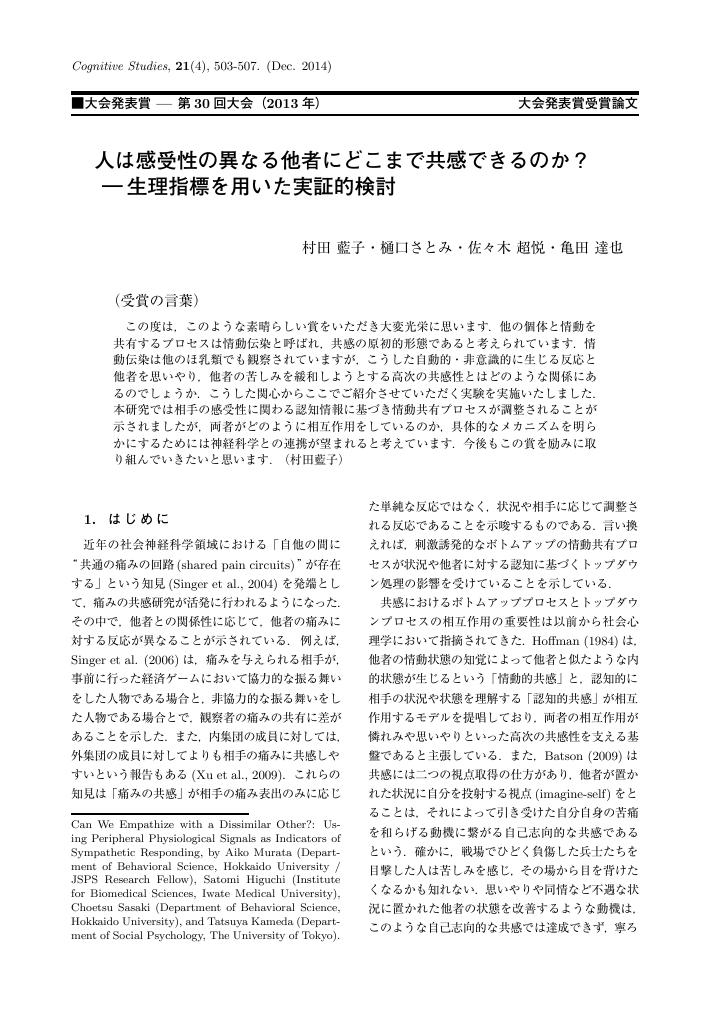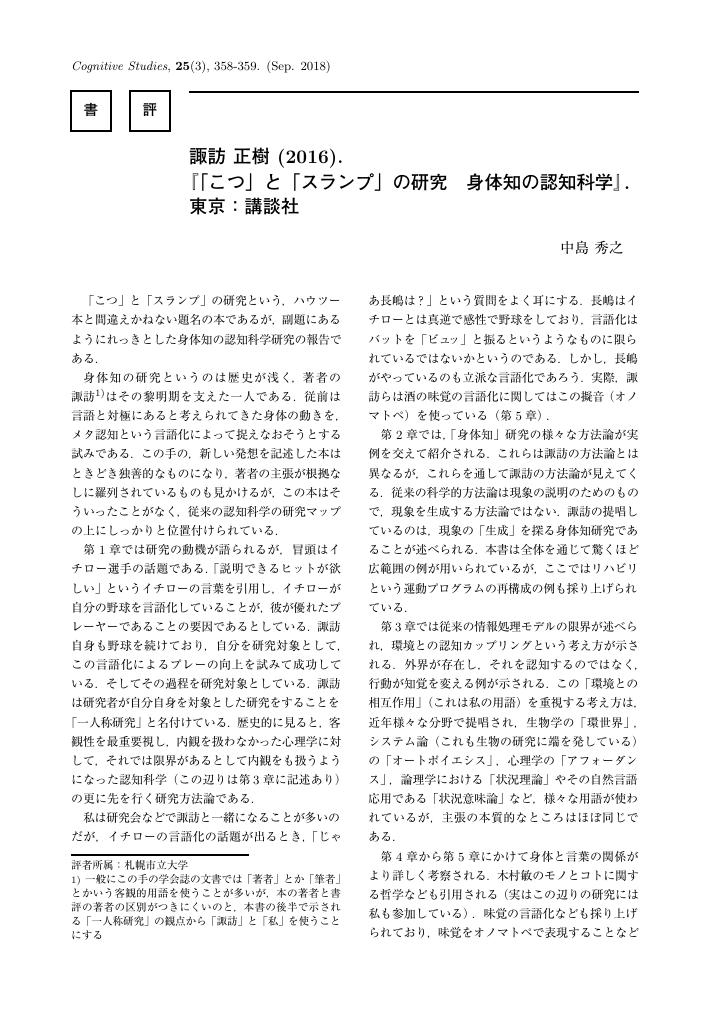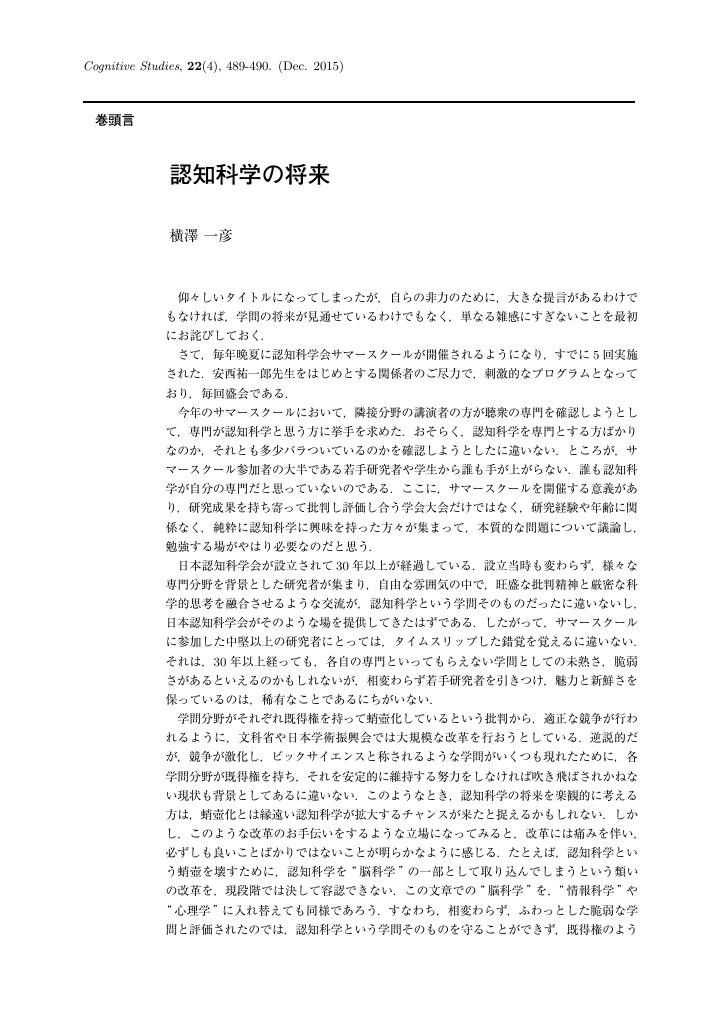1 0 0 0 OA 左視野と右視野の文字の識別率の非対称性に基づく最適停留位置効果の実現
- 著者
- 石原 由紀夫 守田 了
- 出版者
- 日本認知科学会
- 雑誌
- 認知科学 (ISSN:13417924)
- 巻号頁・発行日
- vol.12, no.3, pp.270-286, 2005 (Released:2009-10-16)
- 参考文献数
- 29
During reading spaced text such as English, each word is not refixated very often when eyes initially land on slightly right side of the middle part of the word. However, in identifying an isolated word, the word will be identified more quickly when eyes initially land on slightly left side of the middle part of it. These two initial eye landing positions are called optimal viewing position or OVP, and these two phenomena are called optimal viewing position effect or OVP effect. This paper aims to simulate eye movements using a computer to realize these two OVP effects. Previous studies indicated that the reason for OVP in identifying an isolated word was that letters could be identified more correctly in the right visual field than the left. In our study, in order to get the higher probability of letter identification in the right visual field than the left one, we considered the asymmetry of the number of pixels sampled in the left and right visual field. And we used the gap between subjective and objective viewpoints to quantify the asymmetry. Here, a subjective viewpoint is defined as the point that people look at on an object. Meanwhile an objective viewpoint is defined as the point of the object, on which the straight line passing through the center of pupil and fovea falls. In our experiments, eye movements in identifying an isolated English word and reading English text were simulated using a computer while shifting the objective viewpoint around the subjective viewpoint. As a result, OVP appeared on the left half of a word and on the right half when identifying an isolated English word and reading English text, respectively. These happened only when the objective viewpoint was shifted to the right from the subjective viewpoint by the width of 1 letter.
1 0 0 0 OA 表象変化の動的緩和理論 : 洞察メカニズムの解明に向けて
- 著者
- 開 一夫 鈴木 宏昭
- 出版者
- 日本認知科学会
- 雑誌
- 認知科学 (ISSN:13417924)
- 巻号頁・発行日
- vol.5, no.2, pp.2_69-2_79, 1998-06-01 (Released:2008-10-03)
- 参考文献数
- 23
Research on insight has accumulated empirical evidence on its cognitive processes. However, there is little agreement on what problem-solvers learn from their initial failures and at what point an insight actually takes place. To explore these issues, we first propose a general framework that involves three constraints, object-level, relational, and goal. The object-level and relational constraints represent people's natural preferences of how objects and relations in a given problem are represented. The goal constraint evaluates a degree of match of the current state to the goal, and leads problem-solvers to select specific combinations of the representations of objects and relations. In the processes of insight, these constraints operate simultaneously and are gradually relaxed by repeated impasses. Using a geometric puzzle problem, we empirically tested hypotheses derived from the framework. Experimental results revealed that the initial persistence in a wrong approach could be explained by the object-level and goal constraints, and that subjects could reach an insight by relaxing the object-level constraints as well as allowing easy operation of goal constraints.
1 0 0 0 OA 音楽構造の破壊による音楽情動への影響の調査
- 著者
- 大村 英史 二藤 宏美 岡ノ谷 一夫 古川 聖
- 出版者
- 日本認知科学会
- 雑誌
- 認知科学 (ISSN:13417924)
- 巻号頁・発行日
- vol.20, no.1, pp.152-159, 2013-03-01 (Released:2014-11-20)
- 参考文献数
- 11
- 被引用文献数
- 2
According to Meyer, musical emotion is elicited by deviations from musical expecta-tion. We assume such deviations as a musical complexity. In this study, we focused on the structure of melodies, and created complexities built in either or both types of structures: one made of notes and the other made of grouping hierarchic elements,which we called level 1 structure and level 2 structure. We conducted a psychological experiment revealing relationships between emotion and musical complexities. Par-ticipants assessed musical emotions (GEMS-9) and feeling that something is wrong as sensory psychological quantity of complexities. As the results of ANOVAs, we found that destructions of both level 1 structure and level 2 structure effected feeling that something is wrong. Moreover, destructions of level 2 structure effected tension, sad-ness,andtranscendence of musical emotions. These results indicate that manipulating destructions level of musical structure might control specific musical emotions.
1 0 0 0 OA 人は感受性の異なる他者にどこまで共感できるのか?
1 0 0 0 OA ヒトとヒト以外を隔てるもの:実験心理学の立場から
- 著者
- 嶋崎 恒雄
- 出版者
- 日本認知科学会
- 雑誌
- 認知科学 (ISSN:13417924)
- 巻号頁・発行日
- vol.16, no.1, pp.148-153, 2009 (Released:2010-06-11)
- 参考文献数
- 20
The present article is a comment on the feature “Symmetry: The search for the foundation of thinking, language, and communication” apppeared on Congnitive Studies, 15(3), 2008, from a viewpoint of experimental psychology on the fields of learning and thinking studies. It includes discussion on the biological significance of the experiments both with animal and human, and show the asymmetry of human and animal are not only due to the difference of the biological significance of the experimental situations with referencing data on the retrospective revaluation experiment with human participants. After the discussion, the possibility that the fundamental factor that separates human from infrahuman is the self-concept and self-consciousness is indicated. And in conducting comparative studies on cognitive mechanism and ability, the construction of the model of the self on non-human, such as computer, will be inevitably needed.
1 0 0 0 OA 演劇における演技の反復性がもたらす表現の変化
1 0 0 0 OA 相互行為における援助のリクルートメントに関する研究の紹介
- 著者
- 門田 圭祐
- 出版者
- 日本認知科学会
- 雑誌
- 認知科学 (ISSN:13417924)
- 巻号頁・発行日
- vol.27, no.1, pp.69-75, 2020-03-01 (Released:2020-03-15)
何かを貸してくれるように求めたり,相手が欲しがっている物を差し出したりといった援助は私たちの生活の至るところでおこなわれている.本稿では,そのようなありふれたやりとりが成り立つ仕組みの解明を目指し,人々の発話や身体動作を微視的に分析する相互行為研究の文献を紹介する.ここでの「微視的分析」とは,発話における1 つ1 つの表現の選び方や身体動作におけるタイミングや軌道といった,相互行為の中で時々刻々となされていくふるまいの調整について,その継起関係や共起関係を質的に記述していくような分析を指す. 本稿で紹介する文献は「援助のリクルートメント(recruitment of assistance)」というアイデアに基づき,発話による援助の依頼や身体動作による援助の引き出しを1 つの連続体(continuum)をなすものとして捉え,包括的に扱うことを提案している.第1 論文は,リクルートメントのために用いられる5 つの方法の特定と比較をおこなっている.また,これらの方法に関連して「補助的な行為(subsidiary actions)」というふるまいについて記述をおこなっている.第2 論文は,何かを探している(searching for)ことを示す様々な身体動作に焦点を当て,それらが他者から援助を引き出す方法として用いられていることを示している.なお,第2 論文はオンラインジャーナルに掲載されたものであり,参与者たちのふるまいを文字化したトランスクリプトのみならず,実際のビデオデータを参照しながら読み進めることができる. 以上2 編の文献は,第1 にはコミュニケーション研究を専門とする多くの研究者にとって役立つものだろう.また,人間と共棲するロボットの開発などを専門とする読者にとっても,示唆的な知見が提示されていると思われる.加えて,介護や看護などの実践に携わる方々にとっては,「当たり前」になっているふるまいの巧みさを捉え直し,改善していく手がかりとなるかもしれない.相互行為研究以外の分野を専門とする読者に文献を紹介するにあたり,本稿では事例と分析の概要を示すだけにとどめた.紹介した両文献に関心をもっていただけた方は,ぜひ,元の文献に掲載されている完全な事例と詳細な分析にあたっていただければ幸いである.
1 0 0 0 OA 会長就任のご挨拶: 認知科学研究の質を高めることに向けて
- 著者
- 植田 一博
- 出版者
- 日本認知科学会
- 雑誌
- 認知科学 (ISSN:13417924)
- 巻号頁・発行日
- vol.26, no.1, pp.3-5, 2019-03-01 (Released:2019-09-01)
- 参考文献数
- 1
1 0 0 0 OA 視覚認知と画像統計量
- 著者
- 本吉 勇
- 出版者
- 日本認知科学会
- 雑誌
- 認知科学 (ISSN:13417924)
- 巻号頁・発行日
- vol.21, no.3, pp.304-313, 2014-09-01 (Released:2015-05-12)
- 参考文献数
- 59
Humans easily recognize objects and perceive their attributes such as shape, color,and material. To achieve these high-level functions, it has generally been assumed that the visual system must reconstruct three dimensional surfaces from the retinal image via deep neural computations. However, recent advances in computer vision and psychophysics lead to an alternative scheme that the human visual system utilizes low-level image features and their statistics directly to recognize 3D objects, scenes,materials, and even arts. This heuristics-based vision requires shallow computation,and is indeed suitable for quick and efficient comprehension of objects and stuffs in the real world. However, such a shortcut is insufficient to explain our ability of ’looking through the truth’ via careful scrutiny. The present paper reviews recent findings and debates concerned with this paradigm shift.
1 0 0 0 OA 第1部:小亀説 「鏡像の左右逆」とは何か
- 著者
- 小亀 淳
- 出版者
- 日本認知科学会
- 雑誌
- 認知科学 (ISSN:13417924)
- 巻号頁・発行日
- vol.15, no.3, pp.498-503, 2008 (Released:2010-02-15)
- 参考文献数
- 5
- 被引用文献数
- 7
The substance of the mirror-reversal problem can be thoroughly understood by a completely logical analysis based on the physical knowledge about mirror images without special mental⁄psychological idea, except to see the observer's own mirror image as a real object.
1 0 0 0 OA 意識は圏とみなせるのか:
- 著者
- 日髙 昇平
- 出版者
- 日本認知科学会
- 雑誌
- 認知科学 (ISSN:13417924)
- 巻号頁・発行日
- vol.26, no.4, pp.504-508, 2019-12-01 (Released:2020-03-01)
- 参考文献数
- 9
In their paper of this issue, N. Tsuchiya and H. Saigo have proposed a new approach to understand some aspect of consciousness on the basis of category theoretic notions. In my commentary on it, I will raise a few questions on a central assumption of their arguments, which their theory implicitly requires. That is, first of all, the level and the content of consciousness would be respectively represented by a category. Taking this argument, and extending their instantiation of a category of conscious content, it leads a poorly structured category such as something equivalent to a discrete category. With this, and other critiques raised in this commentary, their category theoretic formulation of consciousness would need a major revision on their presumptions to be any useful model of consciousness.
1 0 0 0 OA 土谷・西郷「圏論による意識の理解」へのコメント
- 著者
- 布山 美慕
- 出版者
- 日本認知科学会
- 雑誌
- 認知科学 (ISSN:13417924)
- 巻号頁・発行日
- vol.26, no.4, pp.478-481, 2019-12-01 (Released:2020-03-01)
- 参考文献数
- 5
Tsuchiya & Saigo (2019) proposed the way of understanding consciousness based on category theory. In this commentary, I discussed four points about their article: 1.Validity of their treatment of the definition and model of consciousness, 2. Verifiability and novelty of their proposal using Yoneda lemma, 3. Lack of extensive review of consciousness studies, and 4. Readers' images and the unity of image.
1 0 0 0 OA 圏論による意識のモデル化と定義
- 著者
- 平 理一郎
- 出版者
- 日本認知科学会
- 雑誌
- 認知科学 (ISSN:13417924)
- 巻号頁・発行日
- vol.26, no.4, pp.492-495, 2019-12-01 (Released:2020-03-01)
- 参考文献数
- 6
“Understanding consciousness through category theory” by N. Tsuchiya and H. Saigo is an ambitious attempt to build up a framework for understanding the level and content of consciousness by category theory with specific examples. I basically agree with all attempts to develop new mathematical tools and apply them to psychological phenomena. However, it seems that there are some mistakes or lack of consideration in the paper, as I point it out as follows. First, I discuss problems that arise when linking the phenomenon of consciousness to the concept of category theory. Second, I argue the significance of using category theory for structural comparison between two systems. Third, I point out a fundamental difficulty in “defining” consciousness by mathematical concepts. Overall, like integrated information theory, the application of category theory does not seem to have solved the conceptual and philosophical problems when dealing with consciousness so far.
- 著者
- 中島 秀之
- 出版者
- 日本認知科学会
- 雑誌
- 認知科学 (ISSN:13417924)
- 巻号頁・発行日
- vol.25, no.3, pp.358-359, 2018-09-01 (Released:2019-02-28)
1 0 0 0 OA 表現法の変遷 ― ラテン修辞学からグループμへ
- 著者
- 小田 淳一
- 出版者
- 日本認知科学会
- 雑誌
- 認知科学 (ISSN:13417924)
- 巻号頁・発行日
- vol.14, no.3, pp.253-268, 2007 (Released:2009-04-24)
- 参考文献数
- 37
- 被引用文献数
- 1
Born as a technique of persuasio, rhetoric has been organized according to five canons in Latin rhetoric. These canons were subsequently reduced down to onlyelocutio, due to various factors such as the invention of typography where the written text replaced the verbal text as the object of elocutio. Elocutio itself was later gradually reduced to kinds of tropes, then to tropes pairings of metaphor and metonymy, and finally to the metaphor. In spite of its declared demise at the end of the 19th century, rhetoric was revived after the latter half of the 20th century by structural linguistics, and modern rhetoric continues to transform in close contact with poetics and semiotics. Among neo-rhetorical researches on the figures, Groupe μ's approach seems to provide one of the most elaborate models. The model regards figures as a system of metaboly, where four simple operations are executed on a text at various elemental levels. The aim of this article is to reinvestigate the whole system of rhetoric from a cognitive viewpoint by presenting not only rhetorical resources -- specifically the figure system of Latin rhetoric (Cicero and Quintilianus) and French classical rhetoric (Dumarsais and Fontanier) which is the legitimate heir to the former -- but also Groupe μ's several productions which have yet to be introduced to academic research apart from Rhétorique générale.
- 著者
- Eve Sweetser
- 出版者
- Japanese Cognitive Science Society
- 雑誌
- 認知科学 (ISSN:13417924)
- 巻号頁・発行日
- vol.3, no.3, pp.3_75-3_86, 1996-08-31 (Released:2008-10-03)
- 参考文献数
- 14
Previous work has shown that there are a number of SUBJECTIVE uses of change predicates; in Sweetser (1996) I suggested some generalizations about which English change predicates are open to such extended interpretations, which do not involve an actual change of an individual entity (Matsumoto (1996a, b) has made interesting generalizations about Japanese change predicates). This paper analyzes another subjective use of change predicates, one where not the subject of the change predicate, but the scale or standard of comparison, is the entity which is interpreted as changing. For example, a professor who is getting older and keeps on teaching 20-year-old students might say, “The students keep getting younger every year.” In fact, not the students' age, but the professor's evaluative scale is changing as the professor ages. I propose an analysis of these usages in terms of mental space structure and figure-ground reversal.
1 0 0 0 OA 研究を一つ仕上げる贅沢:第一回日本認知科学会博士論文コンソーシアム報告
- 著者
- 村山 綾 三浦 麻子
- 出版者
- 日本認知科学会
- 雑誌
- 認知科学 (ISSN:13417924)
- 巻号頁・発行日
- vol.24, no.2, pp.213-219, 2017
This study investigated false alarm effects against interacting with a person who had been indicted in an attempted murder case. Two hundred and forty participants were asked to read a fictional story about such a case. The degree of physical injury of the victim (i.e., minor or permanent damage) and the subsequent truth (i.e., the person was guilty or not) were manipulated. After reading the scenario, the participants were asked to rate their desire to avoid the indicted person and to estimate the risks of either gazing at him or having a conversation. Consistent with Error Management Theory (EMT), the strongest false alarm effect was obtained against having a conversation with a person who was actually guilty as well as when the physical injury of the victim was more severe. We also confirmed false alarm effects in some conditions where the indicted person was not guilty. These results indicate that the general tendency to avoid a person who possibly threatens one 's safety, as suggested by EMT, could be applicable to situations of interaction with the former accused in a criminal case.
1 0 0 0 OA 認知科学の将来
- 著者
- 横澤 一彦
- 出版者
- 日本認知科学会
- 雑誌
- 認知科学 (ISSN:13417924)
- 巻号頁・発行日
- vol.22, no.4, pp.489-490, 2015-12-01 (Released:2016-06-01)
1 0 0 0 IR 裁判員参加意向を規定する要因および意思決定プロセスの差異:制度施行前後の比較
- 著者
- 上市 秀雄 楠見 孝
- 出版者
- 日本認知科学会
- 雑誌
- 認知科学 (ISSN:13417924)
- 巻号頁・発行日
- vol.22, no.3, pp.326-340, 2015
This study examined the relationship between the amount of legal knowledge, knowl-<br>edge of the lay judge system, cognitive factors (i.e., perceived risk to one's life, perceived<br>cost to act as a saiban-in "lay judge," perceived benefit to act as a saiban-in), emotions<br> (anxiety, stress, and anticipated regret), and behaviors (i.e., intentions and requests to<br> act as a saiban-in) in the lay judge system. First, we surveyed a sample of 307 citizens<br>in 2007 and 700 citizens in 2012, and compared the decision-making processes in these<br>two years using structural equation modeling. The results indicated that the effect of<br>perceived benefit to act as a saiban-in on intentions was weaker in 2012 than 2007.<br>In contrast, the effect of perceived cost was stronger in 2012 than in 2007. This may<br> explain why the intention to act as a saiban-in was low in 2012, despite the greater<br> knowledge of saiban-in processes in 2012 than in 2007. Second, the groups in 2012 were<br> (1) males with a decision-making style defined by low responsibility scores, (2) males<br>with high responsibility scores, (3) females with low scores, and (4) females with high<br>scores. We examined the decision-making processes among the groups. For all groups,<br>there was a cognitive process that perceived risk to one's life affected intentions to act<br>as a saiban-in, mediated by the perceived cost to act as a saiban-in. However, emo-<br>tional process differed among groups. Therefore, in order to increase intentions to act<br> a saiban-in, it is necessary to provide information that draws on individual differences<br>(e.g., gender, decision-making style), particularly including emotional content.




